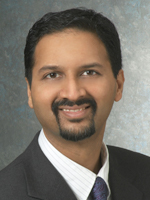Raymond D. Aller, MD, and Hal Weiner
Machine learning: What will it do for pathology?
IICC introduces specification for IVD test results
Website links researchers to human biospecimens
HHS releases cybersecurity quick-response guide
Machine learning: What will it do for pathology?
If finance, online retail, and other industries are “embracing” machine learning, then the medical field is still in the polite handshake phase, despite the potential of this form of artificial intelligence to revolutionize health care. Recent research endeavors highlight just a few examples of what machine learning, which allows computers to analyze data, detect patterns, and build algorithms to guide decision-making, can contribute to the field of pathology alone. At Case Western Reserve University, for example, a deep-learning computer network analyzed 200 whole slide images from biopsies and determined whether invasive breast cancer was present or absent with 100 percent accuracy. In a Stanford University School of Medicine study, a machine-learning approach was used to assess thousands of characteristics of nearly 2,500 whole slide images, accurately differentiate between lung adenocarcinoma and squamous cell carcinoma, and distinguish shorter-term from longer-term survivors in the latter groups. And pathologists at Harvard Medical School employed machine learning to build a decision-support tool that indicates whether a particular molecular variant in cancer should be included in the final pathology report.
CAP TODAY writer Jan Bowers asked four experts to share their thoughts about the use of machine learning in the realm of pathology. Here’s what they said.
How is machine learning influencing the practice of pathology today?

Dr. Madabhushi
Anant Madabhushi, PhD, professor of biomedical engineering, Case Western Reserve University: I don’t think machine learning is at the point where it is directly influencing pathology just yet, but that will soon change. The recent FDA allowance for the marketing of digital slide scanners for primary diagnosis was a major inflection point for the field. This means that a lot more labs are going to want to adopt digital pathology solutions. Machine learning will come slightly later. Once that digital system has been put in place and the kinks have been worked out, then you can get into machine learning and automated interpretation.
Jochen Lennerz, MD, PhD, assistant professor of pathology, Harvard Medical School: Machine learning is having too little impact on pathology. There’s tremendous potential there for having a positive influence, but I think that for many pathologists, the prospect of embracing machine learning is, at first glance, daunting. It’s perceived as computer scientists invading our space, which I don’t think is the case.
Michael Snyder, PhD, professor and chair of genetics, Stanford University School of Medicine: Before machine learning can truly influence the practice of pathology, two things have to happen: We have to show that what we do works, and then let pathologists try it out.
In what ways will machine learning benefit the practice of pathology in the future?

Dr. Lennerz
Dr. Lennerz (Harvard Medical School): Machine learning is one of the pivotal tools that will help us make sense of big data. For example, the decision-support tool that we [Harvard] built captured the collective sign-out experience of six molecular pathologists. The model was based on about 20,000 molecular variants that we’ve encountered for almost 300 different cancers. Each variant, if it were expressed in table format, would have 500 columns of data associated with it—from what chromosome the gene is on, to predicted functional consequences of the encoded amino acid change, etc. That ability to exploit vast amounts of data will have enormous benefit for pathology. In order to change practice, pathologists need to identify truly valuable, cost-efficient use cases that can be argued as better than the current standard. We now have to show that we can use machine learning to change outcomes, change clinical management, and add value in our current practice.
Dr. Madabhushi (Case Western Reserve University): Algorithms such as the ones that our group are developing will have an impact on the practice of pathology. If the machine algorithms can tell which patients have cancer and which do not, this technology can serve as triage for pathologists, freeing their time to concentrate on the cancer patients. In addition, the algorithms can rank order the slides in terms of degree of suspicion so that the pathologist can focus on the tougher cases first. The easier cases might just get triaged, and the pathologist may not end up seeing them at all.
There’s a lot that’s still evolving in terms of which applications and in what particular context machine learning is going to add value. The mining of subvisual images, features that may not be visually discernible by a pathologist, will provide confirmation value to what the pathologist can see from the slide. The question is, what is the use here? How does it simplify my job? Those answers have not really crystallized. I think that once that’s articulated, then you’ll have off-the-shelf solutions to address those needs.
Dr. Snyder (Stanford University School of Medicine): I think that eventually everything will be analyzed using software generated from machine learning. Right now, it’s very subjective—if two pathologists look at the same tissue section in the cancer space, they typically agree about 60 percent of the time. When the software analyzes a section, that takes the subjectivity out, so the results should be much more accurate and more reproducible. In addition, it should definitely improve throughput and workflow and reduce costs—you’ve got a machine looking at thousands of patient samples in a matter of minutes. Even if the pathologist reviews the final results after image processing, the amount of time it takes overall will be much less because the pathologist will simply be concurring or not concurring. I’m very optimistic that this is the future.
Daniel L. Rubin, MD, director of biomedical informatics, Stanford Cancer Institute: I believe that, as in radiology, certain applications will find a place in pathology—for example, those that accelerate workflow, prioritize cases for interpretation and reporting, and detect regions of abnormality. In the long term, I think machine learning will catalyze a closer relationship, and perhaps even convergence, of radiology and pathology . . . given their need for integrating information from multiple modalities, which is greatly aided by machine learning.
 CAP TODAY Pathology/Laboratory Medicine/Laboratory Management
CAP TODAY Pathology/Laboratory Medicine/Laboratory Management
